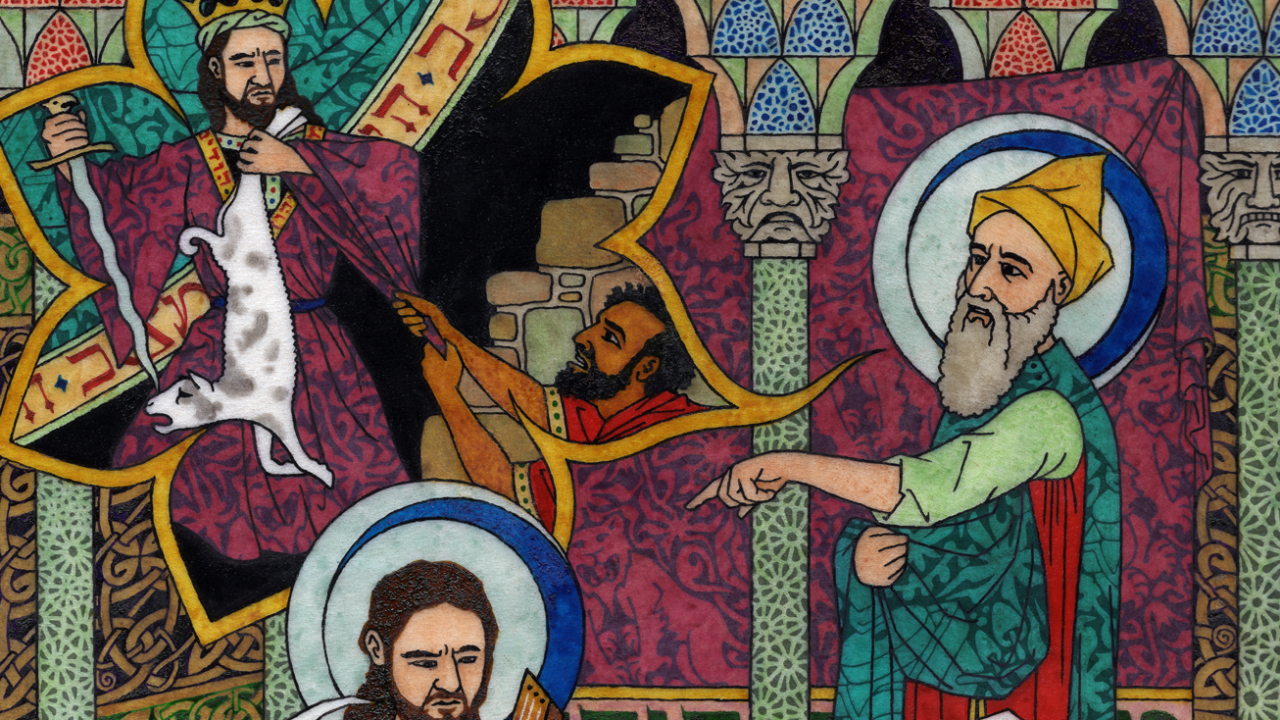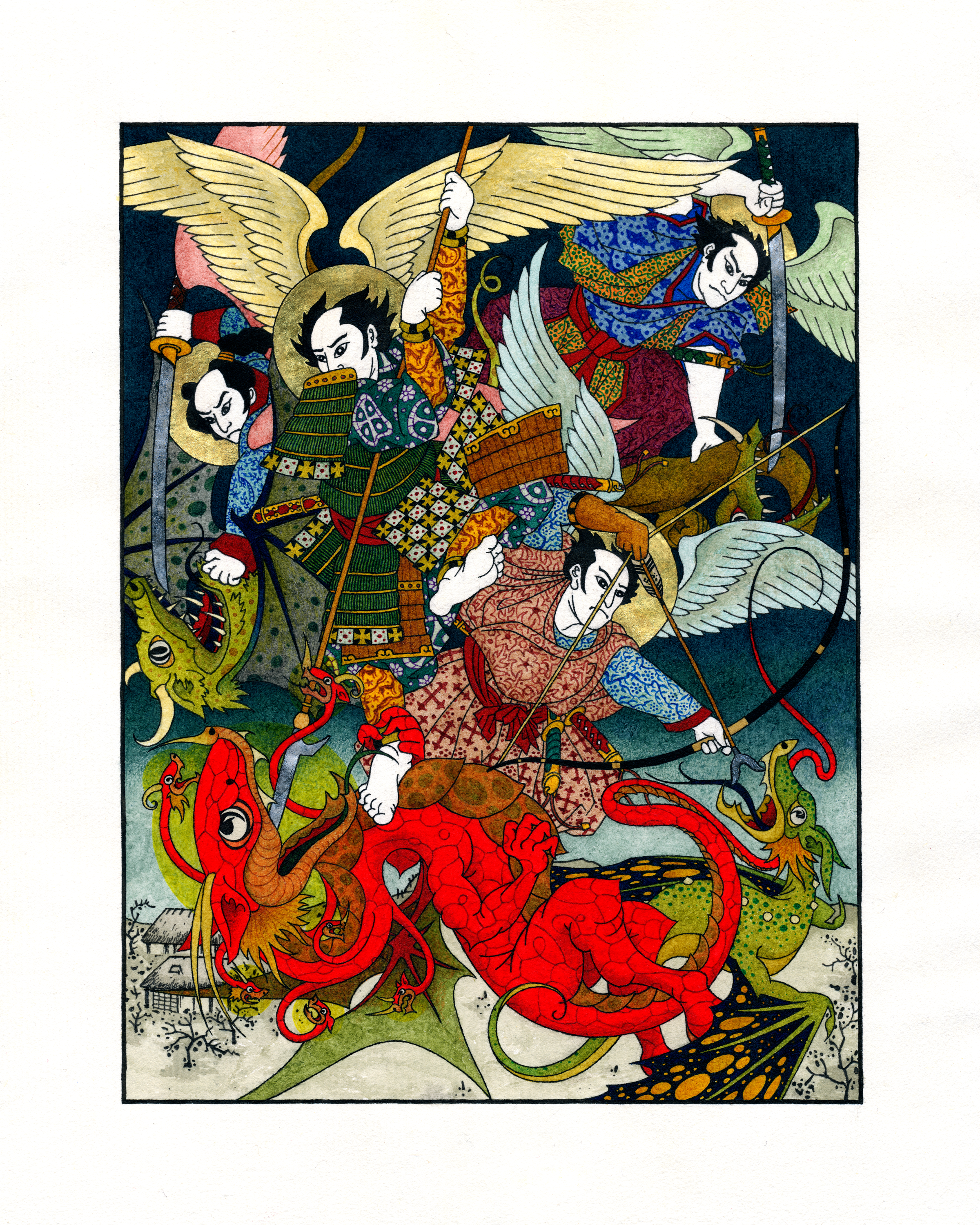“The only really effective apologia for Christianity comes down to two arguments, namely the saints the Church has produced and the art which has grown in her womb.”

This quote from Cardinal Ratzinger (who later became Pope Benedict XVI) has always resonated with me. The stories of holy men and women and the beauty of sacred art (these “arguments” as Pope Benedict XVI called them) are where I turn in times of doubt or spiritual struggle. And the beauty of sacred art was one of the things that drew me to the Catholic Church to begin with. So I’m always eager to discover the work of living artists like Daniel Mitsui who are creating incredible art for the Church.
Daniel Mitsui is a full-time artist as well as a husband and father of four, living in northwest Indiana. His work is deeply influenced by Gothic style as well as Celtic manuscript illumination (especially the Lindisfarne Gospels), Japanese ukiyo-e prints, Persian miniatures, and Russian Folk art. Mitsui is currently working on an ongoing project he calls the Summula Pictoria. It is a set of 244 ink drawings on calfskin, illustrating events from the Old and New Testaments.
I had the pleasure of interviewing Daniel Mitsui about his faith, work, and thoughts on sacred art in the 21st century.

Haley Stewart: Thank you for talking with me, Daniel. Let’s start by talking about your faith. Are you a cradle Catholic? If not, what led you to the Church?
Daniel Mitsui: I was baptized as an adult, at age 22, so no. However, I don’t think I could be called a convert exactly, because growing up I never had any religious belief or identity except a Catholic one. My family went to Mass on Christmas and Easter; we had a crucifix on the wall and a Douay-Rheims Bible on the shelf. I thought of myself as Catholic my entire life, just without having the sacraments. I can’t tell any sort of dramatic conversion story; it would be more honest to say that I always wanted to be a practicing Catholic, but lacked the confidence or initiative to become one for a long time.
It is true that my idea of what it means to be Catholic was formed more by art and history than by parish life, which probably explains a lot about me now.
Why do you think your art is so deeply influenced by Gothic style?
I think that Gothic art is, for several reasons, an especially good basis for art in the Catholic Church. First, because it was a development and elaboration of earlier kinds of sacred art, not a rejection of and replacement for them. So it has a continuity with the earliest traditions of Christianity. Second, because it agrees with traditional liturgy and patristic exegesis in the way it treats symbols, time and space, light and darkness, sacred numbers and directions.
And third, because Gothic art very quickly became an international style. It did not belong to a particular nation, and it was able to absorb influences from everywhere. The concern of the artists was not about keeping the style “pure,” but rather about offering God the very best, no matter whence it came. In the late Middle Ages, Gothic artists imitated aspects of Islamic art; I believe that if the style had endured for a few more centuries, its artists would have imitated aspects of Chinese and American art as well. I don’t think of Gothic art as a historical style that was perfect hundreds of years ago; it is an art based on principles that are enduringly true, and an art that can always be enriched and improved.

Recently, my brother told me a story about how a piece of music heard at just the right moment deeply impacted his spiritual life. It made him wonder how an artist’s obedience to God by sharing his/her talents with the world is connected to the way the Holy Spirit uses that artwork to speak to the hearts of others. Do you think about that when you’re creating art—how God may be guiding your hands to create something that he will use to do something beautiful in someone’s soul, perhaps years or even generations later?
To my mind, an artist should obey God in two ways; first, if he is making art with a religious subject, he should be faithful to the Scriptures and to the traditions of the Church, as known through patristic writings, liturgical texts, and older artwork. He shouldn’t just make everything up. And second, no matter what kind of art he is making, he should make it as beautiful and well-crafted as he is able. He shouldn’t be lazy.
So “obeying God” is something that any artist, really, can do. It’s not some transcendent thing like taking dictation from the Holy Ghost. I certainly can’t claim to be a holy person. And because I am a full-time professional, I can’t afford to make art only when I am feeling spiritually well. I have to put in a full day’s work no matter what, or the bills don’t get paid!
But do I care about leaving a legacy and hope that it will last long after my death? Absolutely.

Glorious works of art are part of the rich tradition of the Catholic Church. Do you think the commitment to prioritize sacred art is declining or wavering in this century? If so, what can we do to right the ship?
It depends on whose commitment we are talking about. If it is the ecclesiastical institutions—dioceses, parishes, seminaries—then sure, almost certainly. But the Catholic Church is more than ecclesiastical institutions; it is everybody who is baptized into it. If sacred art is to be revived, or even continue, the patronage needs to come from ordinary people, and placed in the domestic church rather than the institutional church.
What can lay people do to support Catholic artists and prioritize sacred art?
First, they can realize that art patronage is not just something for institutions and very wealthy people. Anyone can do it. Now, obviously, times are hard and money is tight. Believe me, I know. But a lot of people, at some point or another, have the opportunity to spend a few hundred dollars on something that they don’t absolutely need. Does it occur to them that one of their options is to help bring a new work of art into existence? It may surprise them how many different artists can be commissioned within their means. It is worth considering.
And many artists sell prints of their work; some use crowdsourcing. (I do both.) So there are ways to support artists for less than the cost of an original drawing or painting or sculpture.


How do we teach our children to love sacred art? What is the place of sacred art in the family home, the domestic church?
I think the best way to teach children to love sacred art is to teach them to love art in general, and there are a lot of ways that parents can do that. One mistake that parents make is to treat art education as though it is being done just for the sake of cultural literacy; like, so their kids can sound smart by being able to recognize and talk about the artists that historians deem most important. I think the purpose is rather so that their kids will joyfully interact with the art itself, and so that they will be inspired to make art themselves. And that can be done more effectively by using art that is intentionally made to be engaging to children.
I think the very best thing that parents can do for art education is to assemble a home library of really beautiful picture books. There are so many of these, on every subject imaginable. I could probably talk about picture books for hours; it is a small obsession of mine. And I think picture book illustrators are some of the best artists of the last two centuries. It is perfectly fine if children appreciate the work of Errol Le Cain and Trina Schart Hyman and Nancy Ekholm Burkert more than the work of Caravaggio or Rembrandt or Cézanne. I mean, I certainly do.
Another artistic medium that can be really engaging to children for art education is board games. As an artist, I find it really encouraging to see a traditional medium, one that has been around for thousands of years, going through a golden age right before my eyes.
And another way to teach children to love sacred art is through devotions at home. A domestic shrine or icon corner is really nice to have. And one of the great things about sacred art is that it is meant to be engaged with, not just framed and hung on a wall. There are ways to do this by reviving traditions that started in the churches but have been mostly forgotten there. For example, in the Middle Ages, many churches hung a decorated dove statue from the ceiling on Pentecost, and swung it about during the singing of the Veni Creator Spiritus. A few years ago, my oldest son and I made one out of papier-mâché. We hang it from a hook on the ceiling every Pentecost and leave it up through the season. I have a piece of parchment with the word “Alleluia” calligraphed on it that we bury under the base of a small statue on the Saturday before Septuagesima. We veil the religious statues and pictures throughout the home with cloth napkins for Passiontide. My kids remember and look forward to these things. Medieval liturgy was a lot more fun and charming; anyone who researches it even a little should find inspiration there.


Thank you for taking the time to share about sacred art, Daniel!
Daniel Mitsui’s art can be found at his website, DanielMitsui.com.
